Go Green Coir Mat Blankets are another solution for soil erosion. These are made with 100% coconut fibre with photodegradable or biodegradable top and bottom grids stitched up together. Top and bottom PP net layers hold the coir fiber with the help of stitched yarn.
Coir Blankets are also used to prevent the seeds and prevent the soil losses until vegetation is firmly established. Coir mat can be pre-seeded with selected seeds depending on the location. This helps to reduce the off velocity and moderate moisture and the temperature.Using coir blankets you can prevent soil compaction and crusting. It will resist wind and rain forces. These benefits accelerate vegetative development while the blankets decompose over time and become part of the soil.
This coir mats have been developed for extreme slopes, high-discharge channels and applications requiring permanent protection and reinforcement. Due to increased public environment awareness and rising costs of repairing erosion damaged sites, erosion control have become serious considerations on all projects. Considerations sites with un-vegetated steep slopes and/ or surface drainage ways are prime targets for erosion. Each erosion control blanket/ coir mat is designed for a specified range of erosion control and revegetation conditions considering soil and environmental conditions.
The thickness of the coir blanket differs from one to another according to the specified applications and can be supplied in roll form with a maximum width of 2.4 meters and length of up 50 meters. Considering your requirement and the loadability of the container we can propose the suitable length. Customers are free to discuss about the requirement and we are in a position to propose the right range and all the information you need to know. Each roll is packed with clear and impermeable polypropylene wrapping which shall not undergo deterioration or damage during handling, transportation and storage.
Site Preparation:
Grade and shape the area of installation. If applicable, prepare seedbed by loosening 2” to 3” of topsoil. Fertilizer is recommended prior to seeding and installation of blankets & matting’s. Make sure soil is free of clods, rocks, wood and other obstructions so that the blankets & matting’s are in direct contact with soil.
Seeding:
In most cases, it is recommended that seeding be done prior to installation of blankets. For turf reinforcement mat and open weave matting, seeding is often done after matting installation. Best results are achieved when a veneer of soil is raked over the broadcast seeded surface. Straw or hay mulch may be added after seeding. All check slots and other areas disturbed during installation process should be re-seeded.
Anchoring:
U-shaped metal staples (11-gauge minimum, 6” to 12” long) or wooden stakes (at least 12” long) can be used to anchor blankets to the ground. Keep a minimum edge distance of 2” from the edge of the blankets to the center of the staples or stakes.
Send Us Inquiry Contact Us on Whatsapp








